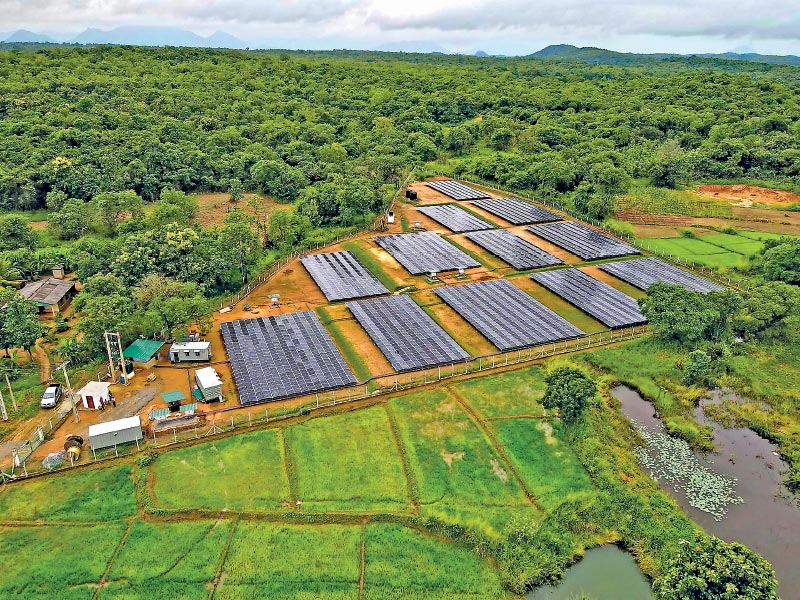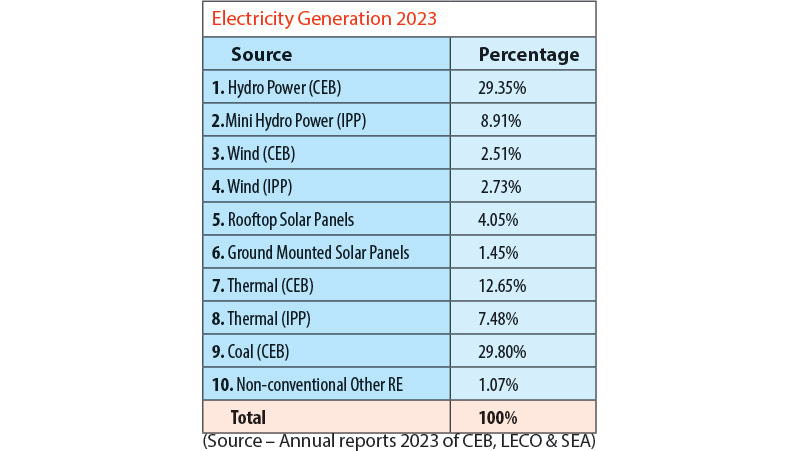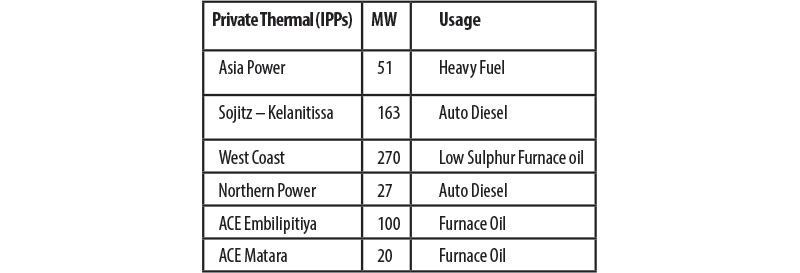Tuesday Nov 04, 2025
Tuesday Nov 04, 2025
Thursday, 31 July 2025 01:27 - - {{hitsCtrl.values.hits}}

The cost of manufacturing solar panels has plummeted dramatically in the last decades, making them an affordable form of electricity
 On 16 July, the Prime Minister at the Seventh Meeting of the International Solar Alliance Regional Committee for the Asia and Pacific Region held in Colombo, emphasised on Sri Lanka’s dedication to strengthening regional solar cooperation and achieving energy security through sustainable development.
On 16 July, the Prime Minister at the Seventh Meeting of the International Solar Alliance Regional Committee for the Asia and Pacific Region held in Colombo, emphasised on Sri Lanka’s dedication to strengthening regional solar cooperation and achieving energy security through sustainable development.
Apparently, the Prime Minister is more concerned of regional solar corporation, rather than the country’s requirement. This brings again the undisclosed agreement the President signed with India. It is clear that India wishes to connect the two countries with an electrical connection and export electricity to Sri Lanka. It is well known that the production cost of India is lower than Sri Lanka.
In March 2025, the Government decided to revise the tariff paid per unit of electricity generated by rooftop solar panels, following recommendations from the Ceylon Electricity Board (CEB) claiming to align with current energy policies and market conditions. Currently, solar energy producers receive Rs. 27 per unit of electricity supplied to the grid. Under the proposed changes, this rate is expected to be reduced, based on the capacity of the individual solar system.
In Kerala, South India electricity tariffs vary, based on usage and consumer category. Currently Kerala State Electricity Board and recent changes include both fixed and energy charges. For example, with currently Indian Rupee costing nearly Rs. 3.50, Indian consumers using 0-40 units pay ₹1.50 per unit or SLR 5.25, while those consuming above 250 units pay ₹8.80 or SLR 30.80 per unit.
Meanwhile, local consumers using up to 60 units a month are charged Rs. 7.85 per month with no fixed charge and consumers using over 121 units are charged Rs. 32 per unit with a fixed charge of Rs. 480. Above shows that Sri Lankans pay higher charges for electricity than the South Indians.
Power generation in Sri Lanka

Table 1 shows that in 2023 wind power contributed 5.25% and solar 5.5% amounting to a small amount compared to 29.8% coal and 20.1% thermal, with 50% dependency on imported fuels, showing the importance of urgently moving over to wind and solar power.

Renewable energy in Sri Lanka
Our renewable energy comes from hydro-electricity, the cheapest, solar, wind power and to a lesser degree to bio-mass. We have almost exhausted all possible hydro-electricity generation sources and in future will have to depend on solar and wind power. The last hydro-power station installed was the Uma Oya power station generating 120 MW of power and was commissioned on 24 April 2024.
Wind power, which needs large investments, is beyond the middle class. Meanwhile, large numbers of houses who could afford have solar power on their roofs. Also, most factories already have solar panels on their roofs, covering most of their electricity costs.
Achieving 70% renewable energy target
Few years ago the Government and the CEB targeted achieving 70% renewable energy by 2030. But recently, CEB announced that Sri Lanka had achieved 70% renewable energy generation in June. The statement received heavy criticism from energy experts and industry insiders, who warned that the claim is misleading and risks creating a false impression about the country’s progress towards its clean energy goals.
Their concern is that the 70% figure is based on a single month’s data, heavily influenced by unusually high hydroelectric generation due to favourable weather conditions, rather than on stable, long-term achievement, also one month’s performance is not only scientifically inaccurate but also misleading the public and policymakers.
This July too Colombo district is experiencing exceptional weather, cloudy skies, but with very few rains. The cloudy skies are due to heavy rains in the hilly mountains, which has led to nearly filling most reservoirs in the mountain region. With oncoming August, weather would change soon, normally a very hot dry period. This would allow hydropower stations to produce power at full capacity, in addition with solar at full capacity, making 70% renewable energy possible again. If CEB engineers are mindful, the situation will allow closing down Norochchalai for few days for servicing. Also closing down oil based power generation for few days.
Solar power Sri Lanka
Photovoltaic (PV), also called solar cells, are electronic devices converting sunlight directly into electricity. Today solar cells are everywhere from calculators to installed on house roofs. PV is one of the fastest-growing renewable energy technologies and will play a major role in the future global electricity generation.
The cost of manufacturing solar panels has plummeted dramatically in the last decades, making them an affordable form of electricity. Solar panels have a lifespan of roughly 25 years.
Sri Lanka receives significant amount of solar radiation across all geographical regions. The Global Horizontal Irradiance (GHI) varies between 1,247 kWh/m2 to 2,106 kWh/m2. It is to be noted that the intensity of solar irradiation in lowland areas is higher compared to mountainous regions. This is largely due to the continuous presence of clouds in mountainous areas and the shadowing effect of mountains.
Sooryabala Sangramaya
On 6 September 2016, the Government launched an enhanced version of the Rooftop Solar Program under the theme “Sooryabala Sangramaya” which converts to “Battle for Solar Power”. Under this program, excess energy exported to the grid can either be carried forward (as originally done in the net-metering scheme) or uncashed (identified as net-accounting), at a tariff of Rs. 22 per kWh during the first seven years and Rs. 15.50 per kWh during the remaining 13 years.
With the significant reduction of cost of solar PV components, the service providers have quickly moved to tap large industrial customers who own large buildings with good roofs for solar PV systems.
My personal experience
I got a solar panel system installed on my roof of capacity 15kW costing Rs. 2.1 million. The system was installed in April 2025 and my previous electricity bills were around Rs. 25 to 30,000 a month. Now, after the solar installation no bills, but occasionally a bill of around Rs. 250 with heavy cloudy weather.
Government reduces payments for solar power
A cabinet paper recommending amending existing payment structure for solar power generation has been submitted to the Cabinet of Ministers, as requested by Ceylon Electricity Board (CEB). The revision claims to align with the current energy policies and market conditions.
At present, solar energy producers receive Rs. 27 per unit of electricity supplied to the grid. The proposed changes, the rates are expected to be reduced, as follows:
The Ministry of Energy clarified that these new tariff rates will apply only to newly installed rooftop solar systems, while existing installations will continue to receive payments at the current rate. The new system would sure to reduce new solar installations. But the Government continue to pay much higher tariffs for oil-based power producers.
Electricity Amendment Bill 2025
The new Bill proposes the abolition of the National Electricity Advisory Council (NEAC) – Sri Lanka’s only multidisciplinary, independent body tasked with overseeing electricity sector reforms and safeguarding public interest. The Bill replaces NEAC with a committee directly appointed and controlled by the Minister of Power, stripping away constitutional protections that ensured NEAC’s autonomy and multidisciplinary expertise.
According to World Bank (2025), countries abolishing similar councils have experienced a 37% reduction in renewable energy project approvals between 2015 and 2022, severely crippling climate action efforts. India’s insulated regulatory model, which empowers independent commissions, has yielded tariff reductions of 22% and improved service quality.
The NPP Government came to power in 2024, campaigned for transparency, institutional reform, and de-politicisation of energy governance. Their manifesto pledged to establish independent, multi-stakeholder regulatory bodies free from political interference, also to guarantee the autonomy of regulators to protect consumer rights and promote sustainable development.
During the last year, almost $ 2.2 trillion was invested in clean energy in the world, which for the first time was higher than the investment in fossil fuels. In addition, there has been a 70% reduction in the price of solar power over the last 10 years. Most countries, while doing competitive bids for solar, are finding that the price for solar energy is substantially lower than new coal or new gas.
Solar power storage in batteries
Generally, solar power is during 9 a.m. to 4:30 p.m. Most factories work from 7 a.m. to 7 p.m. and have solar panels on their large roofs. In households peak demand is during 6:30 to 9:30 p.m. Thus to cover the power shortage, battery storage is a requirement.
In Sri Lanka import taxes on batteries for solar power have reached 46% at the point of import making them expensive compared to other countries. The import duty of 25%, 5% para tariff called port and airport levy and value added tax of 18%. Because electricity is not under Sri Lanka’s value added tax regime, the developers cannot recover the VAT unlike in other sectors by invoicing the CEB.
Meanwhile, CEB has announced a Rs. 45.80 tariff for solar batter energy stored during the day and discharged into the grid between 6:30 p.m. and 10:30 p.m. encouraging battery storage. Currently battery costs are also coming down substantially. But if the Government reduces import duties on solar batteries, it would encourage solar battery usage, for the betterment of the country.
Pumped storage
As for power storage, for use outside sundown hours as 5 p.m. to 8 a.m., other solution after batteries are pumped water storage. With a reservoir above and another below, generated power with sun’s energy during peak hours is used to pump water to the upper reservoir.
Then at night, the pumped water is used as hydropower. So there is a mix of battery storage, pumped storage and other solutions can potentially take care of the evening peak. But the country is yet to have even a single pumped storage, although much is talked about.
Government’s power policy
The Sri Lankan Government wishes to achieve a 70% renewable energy generation by 2030 and becoming carbon neutral by 2050, a target set by the Governments during past 10 years. The Ministry of Power and Energy, Public Utilities Commission of Sri Lanka (PUCSL), and electricity sector service providers take measures to achieve these targets.
But the current Government’s policy of non-starting any new projects, while funds are available is likely to push the country backwards. Now, it will be up to private sector to establish power generation plants with the concurrence of CEB.
Power black-out on 9 February 2025
The incident happened on a Sunday morning with heavy sun and no clouds visible throughout the island, was triggered by a monkey’s disturbance at the 33kV Panadura Grid Substation, leading to a sudden power failure across the national electricity network. The outage occurred on a Sunday, where lower electricity demand coincided with peak solar generation. This imbalance between generation and consumption resulted in widespread system failures, resulting in a complete island-wide blackout.
According to the Committee’s appointed to find reasons for system failure, the blackout was primarily caused by low system stability due to an unprecedentedly high input of solar photovoltaic power. On the Sunday morning with offices and factories closed, solar power was supplying more than half of the country’s electricity demand, significantly reducing the role of traditional power plants which usually provide crucial stabilising inertia to the grid. The Committee reported that traditional thermal power stations, continued to operate, but at minimal capacity, were unable to absorb the grid shock.
Power crisis, answer – faster implementation of solar power
It is clear that with the country’s increasing power usage, it would face a shortage of electricity supply and is forced to depend on oil and coal; both are expensive and are imported. Meanwhile, the current Government seems to be blind to the pending issue.
Sunday Times article
Recently Sunday Times reported the Energy Ministry’s official list of commitments to direct oil-based electricity generation towards low-cost renewable solar and wind sources, while implementing competitive procurement and price to make Sri Lanka a country with the lowest electricity bill in the region.
The proposals include to gradually add 2,000 MW of electricity to the national grid using solar power and to popularise rooftop solar panels and domestic energy storage units.
However, last month, the Government significantly slashed the tariffs the CEB will pay to private producers of rooftop solar power by 20 to 40% compared with previous prices. It also cut tariffs per kilowatt hour of electricity generated through all other renewable sources, including wind, hydro and biomass.
A group of solar power project developers has challenged the move in the Court of Appeal, questioning the legality of the tariff reduction and arguing that it was carried out without the requisite approval of the Public Utilities Commission of Sri Lanka (PUCSL). The case is fixed for support on 4 August.